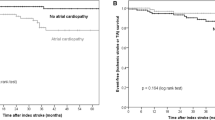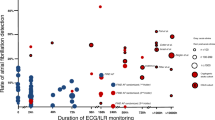Abstract
Atrial fibrillation (AF) is the most common cardiac arrhythmia in adult and old people and represents a risk factor for stroke. Correct AF individuation bears strong relevance in primary and secondary stroke prevention. Our goal was to evaluate the reliability of a low-cost, non-invasive technology in detecting AF in acute stroke patients. AFib model BP3MQ1-2D (Microlife USA, Dunedin, FL) showed good accuracy in diagnosing AF in a general cardiologic outpatient population. We carried out an observational study in patients with recent stroke. We studied 207 subjects, 103 men, 104 women, mean age (±SD) 77.7 ± 11.34 years, who underwent a test by AFib device with indication of AF or lack of it. The golden standard was a 12-lead EKG done immediately and evaluated by a certified cardiologist. We computed estimates of Sensitivity and Specificity and their 95 % confidence intervals (CI). AF was present in 38 subjects from the sample of 207 (18.4 %). AFib correctly demonstrated AF in 34 and failed diagnosing AF in 4 cases; on the other hand, AFib correctly excluded AF in 167 and caused an erroneous diagnosis of AF in 2 cases. The Sensitivity was 0.895 (95 % CI 0.7597–0.958) and the Specificity was 0.988 (95 % CI 0.958–0.997). The AFib device global accuracy was 0.971 (95 % CI 0.938–0.987). This device was able to detect AF with high specificity and a good sensitivity. This device may be considered as an accurate tool in detecting AF in stroke patients.
Similar content being viewed by others
References
Wolf P, Abbott R, Kannel W (1991) Atrial fibrillation as an independent risk factor for stroke: the Framingham Study. Stroke 22:983–988
Go A, Hylek E, Phillips K, Chang Y, Henault L, Selby J, Singer D (2001) Prevalence of diagnosed atrial fibrillation in adults: national implications for rhythm management and stroke prevention: the Anticoagulation and Risk Factors In Atrial Fibrillation (ATRIA) Study. JAMA 285:2370–2375
Miyasaka Y, Barnes M, Gersh B, Cha S, Bailey K, Abhayaratna W, Seward J, Tsang T (2006) Secular trends in incidence of atrial fibrillation in Olmsted County, Minnesota, 1980–2000, and implications on the projections for future prevalence. Circulation 114:119–125
Kimura K, Minematsu K, Yamaguchi T, Japan Multicenter Stroke Investigators’ Collaboration (J-MUSIC) (2005) Atrial fibrillation as a predictive factor for severe stroke and early death in 15,831 patients with acute ischaemic stroke. J Neurol Neurosurg Psychiatry 76:679–683
Marini C, De Santis F, Sacco S, Russo T, Olivieri L, Totaro R, Carolei A (2005) Contribution of atrial fibrillation to incidence and outcome of ischemic stroke results from a population-based study. Stroke 36:1115–1119
Gandolfo C, Balestrino M, Burrone A, Del Sette M, Finocchi C (2008) Stroke due to atrial fibrillation and the attitude to prescribing anticoagulant prevention in Italy. A prospective study of a consecutive stroke population admitted to a comprehensive stroke unit. J Neurol 255:796–802
Furie KL, Goldstein LB, Albers GW, Khatri P, Neyens R, Turakhia MP, Turan TN, Wood KA, American Heart Association Stroke Council, Council on Quality of Care and Outcomes Research, Council on Cardiovascular Nursing, Council on Clinical Cardiology, Council on Peripheral Vascular Disease (2012) Oral antithrombotic agents for the prevention of stroke in nonvalvular atrial fibrillation: a science advisory for healthcare professionals from the American Heart Association/American Stroke Association. Stroke 43:3442–3453
Camm AJ, Lip GY, De Caterina R, Savelieva I, Atar D, Hohnloser SH, Hindricks G, Kirchhof P, ESC Committee for Practice Guidelines-CPG (2012) 2012 focused update of the ESC Guidelines for the management of atrial fibrillation: an update of the 2010 ESC Guidelines for the management of atrial fibrillation—developed with the special contribution of the European Heart Rhythm Association. Europace 14:1385–1413
Connolly SJ, Ezekowitz MD, Yusuf S, Eikelboom J, Oldgren J, Parekh A, Pogue J, Reilly PA, Themeles E, Varrone J, Wang S, Alings M, Xavier D, Zhu J, Diaz R, Lewis BS, Darius H, Diener HC, Joyner CD, Wallentin L (2009) Dabigatran versus warfarin in patients with atrial fibrillation. N Engl J Med 361:1139–1151
Patel MR, Mahaffey KW, Garg J, Pan G, Singer DE, Hacke W, Breithardt G, Halperin JL, Hankey GJ, Piccini JP, Becker RC, Nessel CC, Paolini JF, Berkowitz SD, Fox KA, Califf RM, ROCKET AF Investigators (2011) Rivaroxaban versus warfarin in nonvalvular atrial fibrillation. N Engl J Med 365:883–891
Granger CB, Alexander JH, McMurray JJ, Lopes RD, Hylek EM, Hanna M, Al-Khalidi HR, Ansell J, Atar D, Avezum A, Bahit MC, Diaz R, Easton JD, Ezekowitz JA, Flaker G, Garcia D, Geraldes M, Gersh BJ, Golitsyn S, Goto S, Hermosillo AG, Hohnloser SH, Horowitz J, Mohan P, Jansky P, Lewis BS, Lopez-Sendon JL, Pais P, Parkhomenko A, Verheugt FW, Zhu J, Wallentin L (2011) Apixaban versus warfarin in patients with atrial fibrillation. N Engl J Med 365:981–992
Wiesel J, Wiesel D, Suri R, Messineo FC (2004) The use of a modified sphygmomanometer to detect atrial fibrillation in outpatients. PACE 27:639–643
Stergiou GS, Karpettas N, Protogerou A, Nasothimiou EG, Kyriakidis M (2009) Diagnostic accuracy of a home blood pressure monitor to detect atrial fibrillation. J Hum Hyperten 23:654–658
Wiesel J, Fitzig L, Herschman Y, Messineo FC (2009) Detection of atrial fibrillation using a modified Microlife blood pressure monitor. Am J Hypertens 22:848–852
Wiesel J, Abraham S, Messineo FC (2013) Screening for asymptomatic atrial fibrillation while monitoring the blood pressure at home: trial of regular versus irregular pulse for prevention of stroke (TRIPPS 2.0). Am J Cardiol 111:1598–1601
Armitage P, Berry G (1998) Statistical methods in medical research, 3rd edn. Blackwell, London
Simel DL, Samsa GP, Matchar DB (2001) Likelihood ratios with confidence: sample size estimation for diagnostic test studies. J Clin Epidemiol 44:763–770
Langhorne P, de Villiers L, Pandian JD (2012) Applicability of stroke-unit care to low-income and middle-income countries. Lancet Neurol 11:341–348
Lowres N, Neubeck L, Redfern J, Freedman SB (2013) Screening to identify unknown atrial fibrillation. A systematic review. Thromb Haemost 110:213–222
Lau JK, Lowres N, Neubeck L et al (2013) iPhone ECG application for community screening to detect silent atrial fibrillation: a novel technology to prevent stroke. Int J Cardiol 165:193–194
McManus DD, Lee J, Maitas O, Esa N, Pidikiti R, Carlucci A, Harrington J, Mick E, Chon KH (2013) A novel application for the detection of an irregular pulse using an iPhone 4S in patients with atrial fibrillation. Heart Rhythm 10:315–319
Leary MC, Veluz JS, Caplan LR (2014) Neurologic complications of arrhythmia treatment. In: Biller J, Ferro JM (eds) Neurologic aspects of systemic disease part I, Chap 10. Handbook of Clinical Neurology, vol 119. Elsevier, Amsterdam, pp 129–150
Suzuki S, Sagara K, Otsuka T, Kano H, Matsuno S, Takai H, Uejima T, Oikawa Y, Koike A, Nagashima K, Kirigaya H, Yajima J, Tanabe H, Sawada H, Aizawa T, Yamashita T (2013) Usefulness of frequent supraventricular extrasystoles and a high CHADS2 score to predict first-time appearance of atrial fibrillation. Am J Cardiol 111:1602–1607
Acknowledgments
We thank the following components of the nursing team of our Stroke Unit who performed all evaluations by means of AFib device as well as the 12-lead-standard EKG recordings: Mr. Franco Bixio, Mrs. Paola Bruzzone, Mrs. Antonella Cuomo, Mrs. Cristina Forgione and the Head Nurse Mrs. Adria Ferrari. We also thank the Italian Association against Stroke (A.L.I.Ce.: “Associazione Lotta all’Ictus Cerebrale”) that provided free of charge, three AFib Microlife devices to perform the study.
Conflict of interest
None.
Author information
Authors and Affiliations
Corresponding author
Rights and permissions
About this article
Cite this article
Gandolfo, C., Balestrino, M., Bruno, C. et al. Validation of a simple method for atrial fibrillation screening in patients with stroke. Neurol Sci 36, 1675–1678 (2015). https://doi.org/10.1007/s10072-015-2231-0
Received:
Accepted:
Published:
Issue Date:
DOI: https://doi.org/10.1007/s10072-015-2231-0




